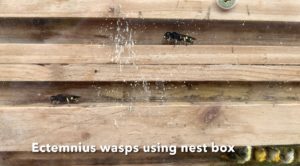Ectemnius solitary wasps
Although there are several species of Ectemnius solitary wasps in the UK, like other wasps, including social wasps, they provide protein in the form of insects for their larvae to feast upon. Ectemnius wasps are out and out hunters of hoverflies and several other fly species. With their large square-ish heads, large eyes and large mandibles they are ideally equipped to hunt flies. After overpowering their prey, they sting it to immobilise it and possibly may also preserve it in some way to keep it fresh. How gruesome!

Why don’t ectemnius wasps use the nest box to nest?
They take the immobilised fly back to the nest as food for their larvae, depositing several others as a stockpile before they lay an egg. The egg hatches and the larva feasts upon the flies. They will also hunt solitary bees as you can see in this film although this bee was a little too large for the unsuccessful wasp, the bee actually flicks the wasps away!

Ecteminius wasp attempting to carry off a mining bee
Not a year goes by without some Ectemnius wasps using my nest box, but only as a sleepover, never ever to nest. So why was this? I set out to find the answer. According to BWARS, they nest inside burrows within dead wood, such as old tree stumps, fallen trunks and limbs, fence posts, even building timbers. Wikipedia goes on to state they will also use rotting logs and sometimes building timbers or posts with the help of the mandibles when making a nest site. I watched one such wasp do exactly that inside an old rotten log I had pre-drilled several holes inside to attract these wasps.
Decoy log
In the film, you will see the sawdust heap a female wasp excavated from the pre-drilled now rotten log. It is several years old and on its last legs! So that worked! I sprinkled this freshly excavated sawdust from these sawdust excavations inside several of my nesting cavities, ones actually previously used by the wasps for their sleepover, in the belief that wasp mandible secretions would have been deposited onto the shavings. I hope it may just be enough to temp (fool really!) a nesting female inside to nest. Not a chance! Having said that it and the sawdust may well have attracted females seeking males, who then used the nest box themselves to rest before they went out in search of females.
It’s obvious now the ectemnius wasps do not like my clean smooth nesting cavities. I take great care to keep them cleaned of wood bits, detritus, and everything else that can find its way inside. My Nurturing Nature solitary bee nest boxes are certainly not rotten wood! They prefer old rotting timbers and having them predrilled certainly helps them. Give it a go yourselves, you have nothing to lose. Unlike me, you may even be lucky enough to see the females stockpile the cavities with flies. Something I have never witnessed. I was not around long enough to film these events. So I guess that all the specimens I have had using my nestbox over the years have either been males resting/sleeping/sheltering inside or females that are sheltering, sleeping but certainly not nesting.
Interesting article “The hoverfly hunting machine” by biologist Dr Africa Gomez
Another solitary wasp article by Dr Isabella Brey “Lone Wolves” includes Ectemnius wasps.
Fabulous photos of males and females on Steven Falks Flickr pages.
Excellent photos here by Jeremy Early of Ectemnius wasps

Recent Comments